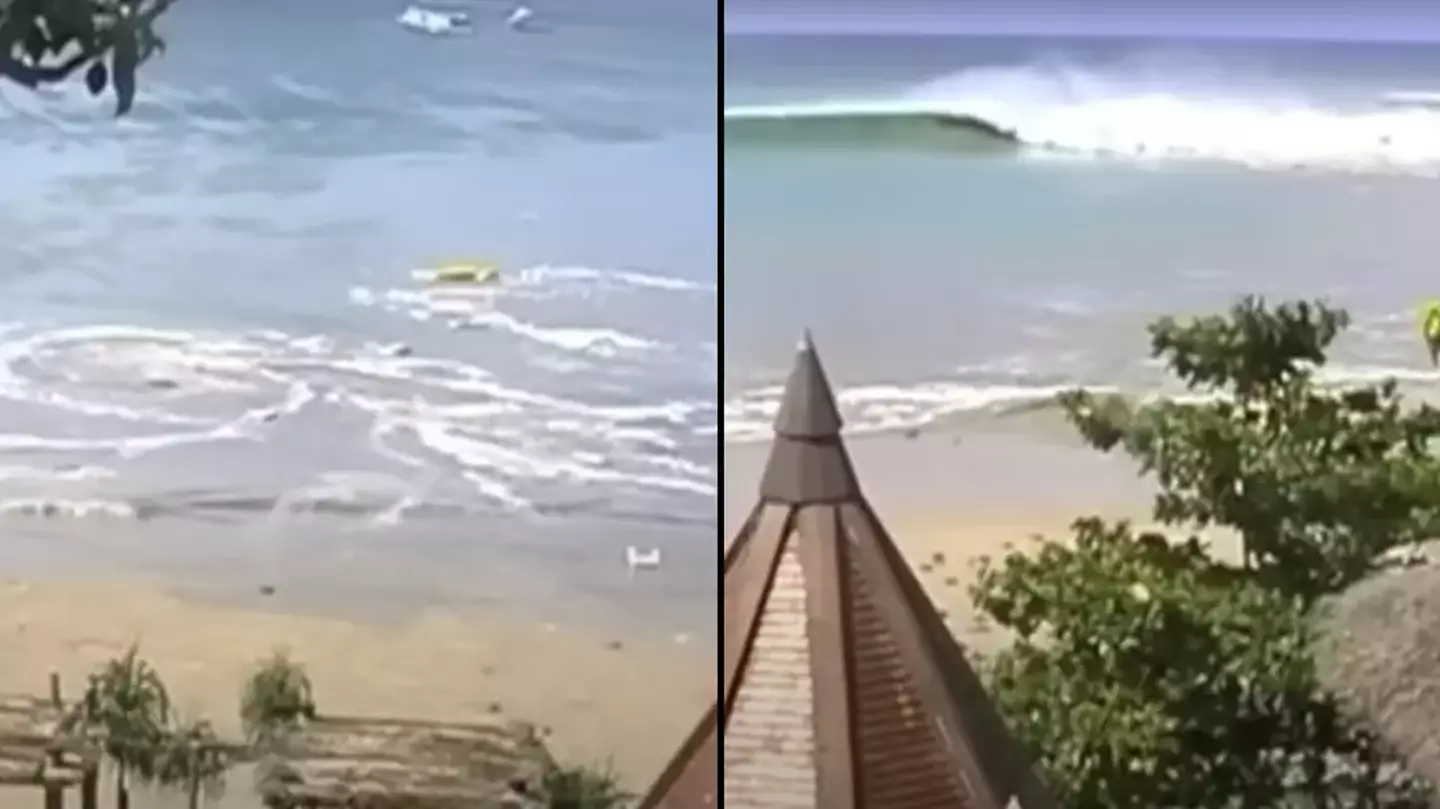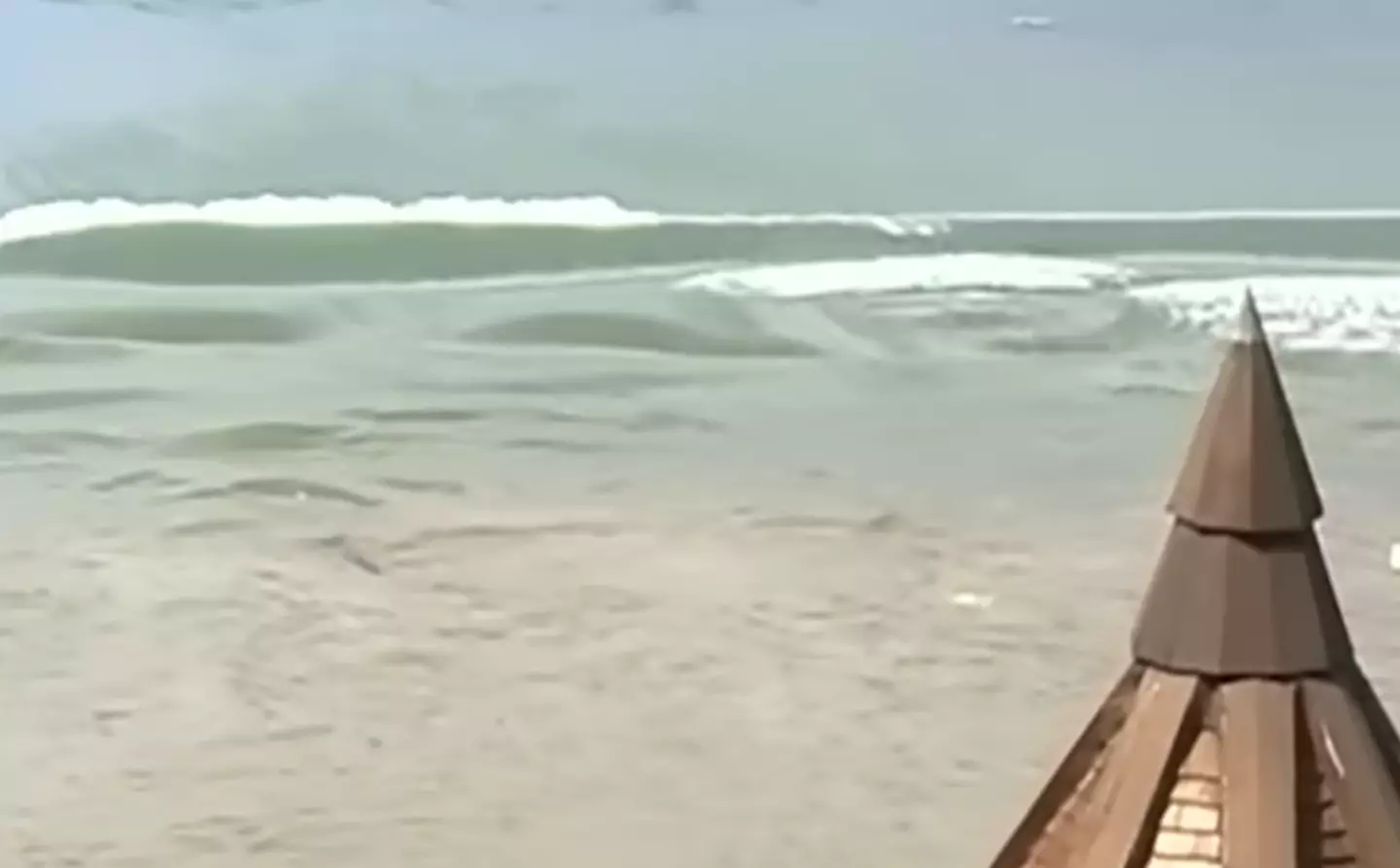
When a devastating tsunami struck several countries in 2004, it killed over 220,000 people and caused damage that would take years to fully repair.
Indonesia, Sri Lanka, India, and Thailand bore the brunt of the tsunami, which began due to the movement of volcanic plates beneath the surface of the sea.
20 miles beneath the ocean floor, the India plate and the Burma microplate subducted, which is where the plates collide and one slides under the other.
That led to an 800-mile rupture, which triggered a massive earthquake that reached a magnitude of 9.1 on the Richter scale.
The movement of the plates also caused the ocean floor to rise by 40 metres, which in turn triggered the tsunami.
As giant waves of destruction headed for the coastlines of multiple countries, some people captured the early stages of the disaster through holiday footage.

Footage of the tsunami showed the waves moving away from the beach (YouTube/Pilot90)
Among the footage is a video showing the frightening power of a tsunami, as people watching it could see the waves were going backwards.
Taken by YouTuber Pilot90, it shows one of the later waves that followed the initial hit of the tsunami, andyou can see the waves moving in reverse.
The reason this happens, according to the National Oceanography Centre, is that a tsunami will draw water back from the beach to ‘feed’ the gargantuan wave.
What you’re seeing is the tide going out with alarming speed and power to feed the next tsunami wave.
Viewers have been stunned and scared by seeing the waves moving in reverse, admitting it was a ‘weird and scary’ sight to see the ocean not behaving how it ought to.
While some were saying how the waves going backwards ‘freaked them out’ thanks to the ‘power and energy underneath the surface of the water’, others pointed out that this was a major warning sign of a tsunami.
They explained that when it looks like the waves are moving in reverse and the water is drained off the beach, it means a tsunami is on the way, as all that water will return with terrifying force.
If you ever see such a thing, then ‘you should be running now’, according to their advice, and try to look for ‘higher ground’.
A survivor of the Boxing Day tsunami of 2004 recalled being swept away from his family, becoming separated from his brother and never seeing his parents again after that.
After the devastation, people from around the world donated billions to help pay for the long repair works.
Featured Image Credit: YouTube/Pilot90
Topics: Weather, World News, Science, YouTube
.png)
A chilling photo of one of the biggest natural disasters in recent history taking place has resurfaced online, revealing the true horror of the destruction and the terror people must have felt.
On Boxing Day 2004, those on the coast of South and Southeast Asia experienced one of the deadliest earthquakes and tsunamis of the 21st century.
The devastating disaster claimed the lives of over 220,000 people, while injuring thousands more in what was the third largest earthquake since 1900.
It took several years to clear up the devastation left behind in affected places such as Indonesia, Sri Lanka, India and Thailand.
On top of the death toll, 139,000 homes were destroyed, as well as 74,000 hectares of agricultural land, thousands of schools, hundreds of health facilities and eight airports/airstrips.
But how did this happen?
Well, it began when the Indian and Burma plates subducted 20 miles below the ocean floor.
But as the tectonic plates collided, an 800-mile rupture was caused – about the same length of Texas – causing a colossal earthquake which was said to have released the same energy as 23,000 Hiroshima-type atomic bombs.
On the richter scale, used to measure the magnitude of an earthquake, anything from 7.0 to 7.9 is categorised as a ‘major earthquake’ causing ‘serious damage’, while anything labeled 8.0 or greater is an earthquake that can ‘totally destroy communities near the epicenter’.
The 2004 Indian Ocean earthquake hit a magnitude of 9.1.

The chilling photo shows how terrifying it must have been for people on the coast that Boxing Day. (AFP/AFP via Getty Images)
The collision of plates cause the ocean floor to rise by 40 metres, triggering a tsunami that would do most of the damage, destroying several coastal areas, as some tourists unknowingly filmed the beginning of the disaster.
Following the earthquake, the sea receded and revealed the seabed, with a giant wall of water heading for the ocean’s surrounding nations.
The photo above reveals how the water quickly receded, with people running desperately for safety after spotting the ‘black giant’ heading for them in the middle of their holiday.
Near the major city of Banda Aceh, Indonesia, waves reached heights of 51m as almost 170,000 people died in Indonesia alone as a result of the disaster.
Sri Lanka is 1,100 miles from Sumatra, and it took two hours for the tsunami to reach the South Asian island. It managed to claim the lives of 35,322 people.

The destruction of the deadly earthquake cost billions to rebuild. (AFP via Getty Images)
The tsunami also hit the coasts of Thailand, where several tourists had been enjoying a hot festive period, especially on the island of Phuket, as 8,000 people died on the country’s shores alone after it hit.
Some other countries that were effected were Somalia, Maldives, Malaysia, Myanmar and Tanzania.
In total, there were almost 230,000 fatalities across the 14 affected countries, with donations totalling $6.25 billion (£4.7 billion) as the world tried to assist in the rescue of people affected by the event.
The overall fatality figure included approximately 9,000 foreign tourists that came from several other nations, making the 2004 Indian Ocean tsunami and earthquake one of the worst natural disasters in history.
Featured Image Credit: AFP/AFP via Getty Images
Topics: News, World News, History


